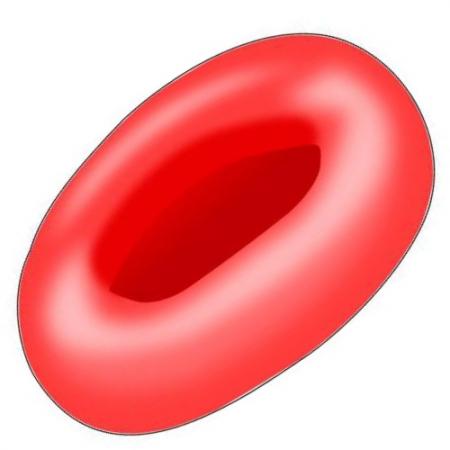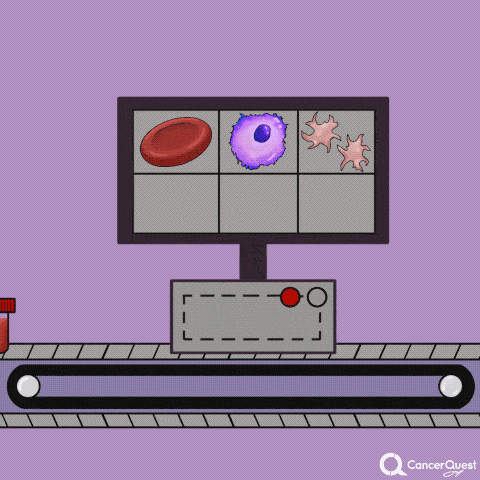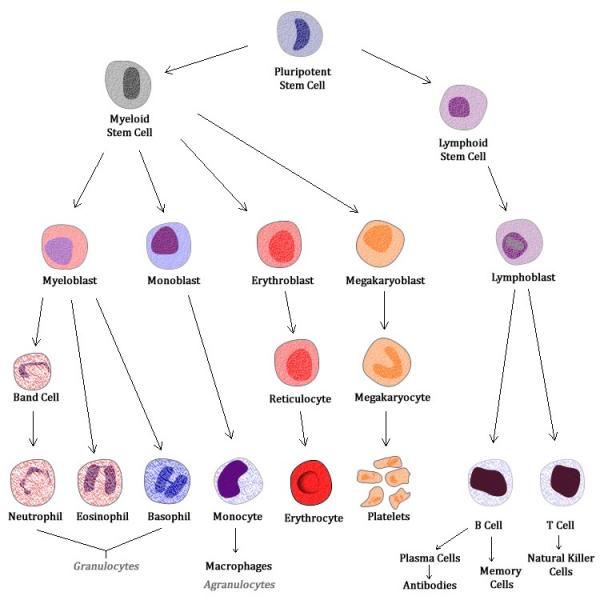
This section contains information on blood, blood cells and common blood tests. Topics covered include:
- Blood Tests
- White Blood Cells
- Red Blood Cells
- Blood cell lineage
- Blood tests and blood cell cancers (leukemia, lymphoma, myeloma, RBC cancers)
Blood has been substance of great interest to humans throughout history and it was one of the elements in the 'Four Humors' theory of life developed by Hippocrates, known as the "Father of Medicine". Today there is a much greater understanding of blood; what it is, what it does, and where it comes from.
The average adult human has about 5.5 L (~185 fluid ounces; 1 gallon=128 ounces) of blood, made up of fluid (plasma) and cells. The plasma makes up ~55% of blood and it contains water (~90%), proteins, nutrients, hormones, chemicals, and waste products. Blood cells make up the other 45%. 1 There are 3 main types of blood cells; white blood cells (WBCs) also called leukocytes ('leuko' comes from the Greek word for white and 'cyte' refers to cells); red blood cells (RBCs), also called erythrocytes; and platelets, also called thrombocytes. All blood cells are formed in the bone marrow from a mother cell called the pluripotential [pluripotent means having more than one possible outcome] stem cell (PSC). These special cells can develop into any of the 3 types of blood cells. (Note: when blood clots, the fluid that remains is called serum. Serum is plasma that no longer contains clotting factors.)
Blood Tests
Today, blood tests are some of the most common and useful screening and diagnostic tools used by doctors. These tests can give important information about how the body is functioning. Some blood tests detect/measure chemicals present in the blood. Others examine the blood cells; one form of this kind of test is called a complete blood count (CBC) and it provides information about the number, parts, shape, and structure of the different cell types found in blood.
The amount of each type of cell in the blood is one of the important indicators of overall health. If any cell type is not present in "normal amounts" there may be a cause for concern, but it does not always signify a serious condition. There are a variety of things that can cause an increase or decrease in blood cell counts, visit a health care professional if you are concerned.
White Blood Cells
White blood cells (leukocytes) are major players in the immune system and help defend against infection and disease. There are several different types of white blood cells with different functions. Based on their functions, WBC can be divided into two main groups; phagocytes and lymphocytes. Phagocytes are capable of engulfing/destroying waste products and foreign matter including infectious agents like bacteria. Lymphocytes guide and participate in the specific immune response. (Learn More about the immune system).
Phagocytes
Phagocytes are cells that are able to consume and break down foreign material, invading microbes and broken down cells/cell parts. They get their name from the Greek 'phagein', to eat. Several different blood cells are able to perform this task.
Granulocytes (neutrophils, basophils, eosinophils)
These cells are called granulocytes because they contain numerous particles (granules). The granules contain chemicals and proteins that are released from the cells to help control inflammatory and immune functions. Granulocytes are also capable of engulfing and destroying foreign matter. They include the following types of cells :
**Normal values are noted in parenthesis 1
- Neutrophils (3,000-7,000 cells/µL; 60-70% of WBC)
These cells make up more than half of the white blood cells in circulation. They are also called segs or polys, because of the unusual (segmented or polymorphic) structure of their nuclei. Neutrophils are usually the first cells to arrive at the scene of infection or inflammation (usually within 90 min). They engulf and destroy foreign matter and then die, forming pus. In cases of increased demand for neutrophils, immature neutrophils may be released from the bone marrow. These immature cells are commonly called bands or stabs because of their appearance. - Eosinophils (50-400 cells/µL; 1-5% of WBC)
The role of eosinophils is not yet completely understood. They are known to play a role in parasitic infections and allergic reactions. People with chronic allergic reactions (such as asthma) usually have a higher number of circulating eosinophils. - Basophils (25-100 cells/µL; 0-.75% of WBC)
These cells are stimulated by other immune cells and play a role in systemic allergic reactions.
Agranulocytes (monocytes, macrophages)
These cells are called agranulocytes because they lack the granules of granulocytes. Agranulocytes are capable of engulfing and destroying foreign matter.
- Monocytes/macrophages (100-800 cells/µL; 3-7% of WBC)
These cells are the largest type of white blood cell. They move through the bloodstream and eventually end up in the tissues. Once they leave the bloodstream and enter tissues they mature into macrophages. There are actually several different types of macrophages with different functions, each one specific to the type of tissue in which they are living (examples: macrophages in bone are called osteoclasts and macrophages in neural tissue are called microglia). After neutrophils, macrophages are usually the second cells on the scene of a problem. They engulf and process foreign matter so that lymphocytes can recognize it and mount a specific defense.
**Normal values are noted in parenthesis
Lymphocytes (1,000-4,000 cells/µL; 25-33%)
These are recognition cells responsible for initiating the specific immune response of the immune system. Lymphocytes are the second most common (neutrophils are most common) circulating white blood cells. There are three major types of lymphocytes- B cells, T cells, and natural killer cells (NK cells). These cells are further divided into subtypes based on their function.
- T Cells (800-3,200 cells/µL; 80% of total lymphocytes)
Formed by the pluripotent stem cells in the bone marrow, T-cells mature in the thymus (a small organ located in the upper portion of the chest). There are two subtypes of T cells; cytotoxic T cells (CD8 cells) and helper T cells (CD4 cells).- Cytotoxic T cells (CD8 cells) bind specifically to target cells; virally infected cells, cancer cells, or any foreign cells. After binding, cytotoxic T cells directly destroy the target cell.
- Helper T cells (CD4 cells) release special chemicals that help activate other cells of the immune response, including; B cells, cytotoxic T cells, other helper T cells, NK cells, and macrophages.
- B Cells (100-600 cells/µL; 10-15% of total lymphocytes). These cells are produced from the pluripotent stem cells in the bone marrow and stay in the marrow to mature. B cells are in charge of antibody production. B cells bind to their specific antigens, become activated 'plasma' cells and secrete large amounts antibodies.
- Natural Killer Cells (50-400 cells/µL; 5-10% of total lymphocytes). Natural killer cells (NK cells) bind to virally infected cells and cancer cells and directly kill them.
When it is useful, blood tests can break down the total WBC count and measure the amounts of the individual cell types as a percentage of the total white cell count. This is called a differential cell count, often called white blood cell count with differential.
Total White Blood Cell Count (4,500-11,000 cells/µL)
Red Blood Cells
Red Blood Cells
Red blood cells (also called erythrocytes) pick up oxygen in the lungs and deliver it to the rest of the cells in the body. When they drop off oxygen, they pick up carbon dioxide, a waste product of cells that must be removed from the body. With each full breath oxygen enters the lungs and carbon dioxide is removed from the lungs.
An individual red blood cell has a life span of around 120 days. Approximately 1% of erythrocytes are replaced each day. That works out to approximately 250 billion cells! A normal RBC count for an adult male is between 4.6x1012 and 6.2x1012 per liter of blood. That's 6,200,000,000,000 or 6.2 trillion red blood cells per liter of blood and as stated earlier, normal adults have around 5.5 liters of blood...that's a LOT of cells!
Red Blood Cell Normal Range 1
- Adult male: 4.6 - 6.2 million/µL
- Adult female: 4.2 - 5.4 million/µL
Red blood cells are produced in the bone marrow from precursor stem cells. They are released from the marrow as immature red blood cells, called reticulocytes, and mature in the span of a day. There are several nutrients necessary for the production of healthy red blood cells including vitamin B12, folic acid, and iron. A person deficient in one or more of these may have low RBC counts.
Along with a numerical count of red blood cells, their structure and function may be examined in a blood test. The features of a typical RBC test are described below.
Hemoglobin
Each red blood cell carries around 300 million molecules of a protein called hemoglobin. Hemoglobin is what actually grabs and carries oxygen. Each molecule of hemoglobin can carry 4 molecules of oxygen. That means one red blood cell can carry over 1 billion molecules of oxygen. Hemoglobin is normally measured in grams per dL (10 dL = 1 Liter).
Hemoglobin Normal Range
- Adult male: 13.5 - 18 g/dL
- Adult female: 12 - 16 g/dL
Hematocrit
The hematocrit is the proportion of red blood cells to an entire sample of blood (red blood cells/blood). It may also be called packed cell volume (PCV) and it is normally represented as a percentage. For example, a hematocrit of 30% means there are 30 milliliters of red blood cells in 100 milliliters of blood.
Hematocrit Normal Range
- Adult male: 40 - 54%
- Adult female: 38 - 47%
Note: The total red blood cell count, hemoglobin, and hematocrit are related to each other; if one changes, the others usually change.
Reticulocyte Count
The reticulocyte count is the percentage of immature red blood cells (reticulocytes) in the total red blood cell count (reticulocytes / red blood cells).
Reticulocyte Count Normal Range
- 1-2% of the total RBC count
Red Blood Cell Indices
The RBC indices evaluate the structure of red blood cells and hemoglobin. They include mean corpuscular volume (MCV), mean corpuscular hemoglobin (MCH), and mean corpuscle hemoglobin concentration (MCHC). These are used mainly to classify different types of anemia.
MCV describes the size or volume of RBCs and classifies them as microcytic (small), normocytic (normal), and macrocytic (large). MCV is usually measured in micrometers cubed (µm3; 1,000,000 µm = 1 meter or about 3.3 feet).
MCV Normal Range
- 82 - 93 µm3
MCH describes the average weight of the hemoglobin in the RBCs. A small RBC will have a smaller MCH. MCH is usually measured in picograms (pg; 1 trillion pg = 1 gram).
MCH Normal Range
- 26 - 34 pg
MCHC describes the average concentration of hemoglobin in the RBCs and classifies them as hypochromic (low concentration, pale color), normochromic (normal concentration, normal color), and hyperchromic (increased concentration, bright red color). MCHC is usually measured as a percentage.
MCHC Normal Range
- 31 - 38%

In a complete blood count (CBC), all of the different kinds of cells in a sample of blood are counted. It is possible to find out if there are too many or too few of each type of cell. Some infections and blood cancers can be detected this way.
Blood Cell Lineage
The diagram below shows the different kinds of blood cells and their relationship to each other. All of the cells originate from a single type of cell (the pluripotent stem cell) that is found in bone marrow. Stem cells are able to change into different types of cells. The process is called differentiation and the result is a variety of different blood cells with different functions.

Blood Tests for Patients with Blood Cell Cancers (Leukemia, Lymphoma, Myeloma, RBC cancers)
For some patients with leukemia, lymphoma, myeloma, or cancers arising in red blood cells (RBC), blood tests can be used to detect disease and track the response of the disease to treatment. The diagram below shows how cancer cells can crowd out normal cells in the blood. This can be detected by counting the types of cells present in a sample of blood.

